Fixed Flexible Spiral Wire Retainers and Unwanted Tooth Movements: A Case Report
Abstract
:1. Introduction
2. Materials and Methods
- Patient information
- Clinical Findings
- Timeline
- Diagnostic Assessment
2.1. Diagnosis
2.2. Prognosis
- Therapeutic intervention
3. Results
3.1. Follow-Up and Outcomes
3.1.1. Clinician- and Patient-Assessed Outcomes
3.1.2. Important Follow-Up Test Results
3.1.3. Intervention Adherence and Tolerability
3.1.4. Adverse and Unanticipated Events
4. Discussion
5. Conclusions
Supplementary Materials
Author Contributions
Funding
Institutional Review Board Statement
Informed Consent Statement
Data Availability Statement
Acknowledgments
Conflicts of Interest
References
- Oppenheim, A. Crisis in orthodontia. Part I. Tissue changes during retention. Int. J. Orthod. 1934, 20, 639–644. [Google Scholar]
- Thilander, B. Orthodontic relapse versus natural development. Am. J. Orthod. Dentofac. Orthop. 2000, 117, 562–563. [Google Scholar] [CrossRef] [PubMed]
- Massaro, C.; Miranda, F.; Janson, G.; Rodrigues de Almeida, R.; Pinzan, A.; Martins, D.R.; Garib, D. Maturational changes of the normal occlusion: A 40-year follow-up. Am. J. Orthod. Dentofac. Orthop. 2018, 154, 188–200. [Google Scholar] [CrossRef] [PubMed]
- Knierim, R.W. Invisible lower cuspid to cuspid retainer. Angle Orthod. 1973, 43, 218–220. [Google Scholar] [PubMed]
- Al-Jasser, R.; Al-Subaie, M.; Al-Jasser, N.; Al-Rasheed, A. Rotational relapse of anterior teeth following orthodontic treatment and circumferential supracrestal fiberotomy. Saudi Dent. J. 2020, 32, 293–299. [Google Scholar] [CrossRef] [PubMed]
- Aasen, T.O.; Espeland, L. An approach to maintain orthodontic alignment of lower incisors without the use of retainers. Eur. J. Orthod. 2005, 27, 209–214. [Google Scholar] [CrossRef] [PubMed]
- Fudalej, P.S.; Renkema, A.M. A brief history of orthodontic retention. Br. Dent. J. 2021, 230, 777–780. [Google Scholar] [CrossRef] [PubMed]
- Padmos, J.A.D.; Fudalej, P.S.; Renkema, A.M. Epidemiologic study of orthodontic retention procedures. Am. J. Orthod. Dentofac. Orthop. 2018, 153, 496–504. [Google Scholar] [CrossRef] [PubMed]
- Renkema, A.M.; Renkema, A.; Bronkhorst, E.; Katsaros, C. Long-term effectiveness of canine-to-canine bonded flexible spiral wire lingual retainers. Am. J. Orthod. Dentofac. Orthop. 2011, 139, 614–621. [Google Scholar] [CrossRef] [PubMed]
- Jedliński, M.; Grocholewicz, K.; Mazur, M.; Janiszewska-Olszowska, J. What causes failure of fixed orthodontic retention?—Systematic review and meta-analysis of clinical studies. Head Face Med. 2021, 17, 32. [Google Scholar] [CrossRef]
- Gelin, E.; Seidel, L.; Bruwier, A.; Albert, A.; Charavet, C. Innovative customized CAD/CAM nickel-titanium lingual retainer versus standard stainless-steel lingual retainer: A randomized controlled trial. Korean J. Orthod. 2020, 50, 373–382. [Google Scholar] [CrossRef] [PubMed]
- Radlanski, R.J.; Zain, N.D. Stability of the Bonded Lingual Wire Retainer? A Study of the Initial Bond Strength. J. Orofac. Orthop. 2004, 65, 321–335. [Google Scholar] [CrossRef] [PubMed]
- Shaughnessy, T.G.; Proffit, W.R.; Samara, S.A. Inadvertent tooth movement with fixed lingual retainers. Am. J. Orthod. Dentofac. Orthop. 2016, 149, 277–286. [Google Scholar] [CrossRef] [PubMed] [Green Version]
- Bellini-Pereira, S.A.; Aliaga-Del Castillo, A.; Dos Santos, C.C.O.; Henriques, J.F.C.; Janson, G.; Normando, D. Treatment stability with bonded versus vacuum-formed retainers: A systematic review of randomized clinical trials. Eur. J. Orthod. 2022, 44, 187–196. [Google Scholar] [CrossRef]
- Juloski, J.; Glisic, B.; Vandevska-Radunovic, V. Long-term influence of fixed lingual retainers on the development of gingival recession: A retrospective, longitudinal cohort study. Angle Orthod. 2017, 87, 658–664. [Google Scholar] [CrossRef] [Green Version]
- Katsaros, C.; Livas, C.; Renkema, A.M. Unexpected complications of bonded mandibular lingual retainers. Am. J. Orthod. Dentofac. Orthop. 2007, 132, 838–841. [Google Scholar] [CrossRef]
- Renkema, A.M.; Fudalej, P.S.; Renkema, A.A.P.; Abbas, F.; Bronkhorst, E.; Katsaros, C. Gingival labial recessions in orthodontically treated and untreated individuals: A case-control study. J. Clin. Periodontol. 2013, 40, 631–637. [Google Scholar] [CrossRef]
- Seo, Y.J.; Kim, S.J.; Munkhshur, J.; Chung, K.R.; Ngan, P.; Kim, S.H. Treatment and retention of relapsed anterior open-bite with low tongue posture and tongue-tie: A 10-year follow-up. Korean J. Orthod. 2014, 44, 203–216. [Google Scholar] [CrossRef] [Green Version]
- Sfondrini, M.F.; Pascadopoli, M.; Beccari, S.; Beccari, G.; Rizzi, C.; Gandini, P.; Scribante, A. Orthodontic Fixed Retainer and Unwanted Movements of Lower Anterior Teeth: Case report. Case Rep. Dent. 2022, 2, 3100360. [Google Scholar] [CrossRef]
- Singh, P. Canine avulsion: An extreme complication of a fixed mandibular lingual retainer. Am. J. Orthod. Dentofac. Orthop. 2021, 160, 473–477. [Google Scholar] [CrossRef]
- Riley, D.S.; Barber, M.S.; Kienle, G.S.; Aronson, J.K.; von Schoen-Angerer, T.; Tugwell, P.; Kiene, H.; Helfand, M.; Altman, D.G.; Sox, H.; et al. CARE guidelines for case reports: Explanation and elaboration document. J. Clin. Epidemiol. 2017, 89, 218–235. [Google Scholar] [CrossRef]
- Richmond, S.; Shaw, W.C.; O'Brien, K.D.; Buchanan, I.B.; Jones, R.; Stephens, C.D.; Roberts, C.T.; Andrews, M. The development of the PAR Index (Peer Assessment Rating): Reliability and validity. Eur. J. Orthod. 1992, 14, 125–139. [Google Scholar] [CrossRef] [PubMed]
- Knaup, I.; Bartz, J.R.; Schulze-Späte, U.; Craveiro, R.B.; Kirschneck, C.; Wolf, M. Side effects of twistflex retainers—3D evaluation of tooth movement after retainer debonding. J. Orofac. Orthop. 2021, 82, 121–130. [Google Scholar] [CrossRef] [PubMed]
- Årtun, J.; Van ’t Hullenaar, R.; Doppel, D.; Kuijpers-Jagtman, A.M. Identification of orthodontic patients at risk of severe apical root resorption. Am. J. Orthod. Dentofac. Orthop. 2009, 135, 448–455. [Google Scholar] [CrossRef] [PubMed]
- Arnold, D.T.; Dalstra, M.; Verna, C. Torque resistance of different stainless steel wires commonly used for fixed retainers in orthodontics. J. Orthod. 2016, 43, 121–129. [Google Scholar] [CrossRef]
- Littlewood, S.J.; Millett, D.T.; Doubleday, B.; Bearn, D.R.; Worthington, H.V. Retention procedures for stabilising tooth position after treatment with orthodontic braces. Cochrane Database Syst. Rev. 2016, 1, 1–139. [Google Scholar] [CrossRef] [Green Version]
- EFOSA’s Self Assessment System Quality Development in Orthodontics. Available online: https://esas.nu/ (accessed on 6 June 2022).
- Kučera, J.; Marek, I. Unexpected complications associated with mandibular fixed retainers: A retrospective study. Am. J. Orthod. Dentofac. Orthop. 2016, 149, 202–211. [Google Scholar] [CrossRef]
- Pazera, P.; Fudalej, P.; Katsaros, C. Severe complication of a bonded mandibular lingual retainer. Am. J. Orthod. Dentofac. Orthop. 2012, 142, 406–409. [Google Scholar] [CrossRef]
- Kartal, Y.; Kaya, B. Fixed Orthodontic Retainers: A review. Turk. J. Orthod. 2019, 32, 110–114. [Google Scholar] [CrossRef]
- Segal, G.R.; Schiffman, P.H.; Tuncay, O.C. Meta analysis of the treatment-related factors of external apical root resorption. Orthod. Craniofac Res. 2004, 7, 71–78. [Google Scholar] [CrossRef]
- Karaman, A.I.; Kir, N.; Belli, S. Four applications of reinforced polyethylene fiber material in orthodontic practice. Am. J. Orthod. Dentofac. Orthop. 2002, 121, 650–654. [Google Scholar] [CrossRef] [PubMed]
- Scribante, A.; Sfondrini, M.F.; Broggini, S.; D'Allocco, M.; Gandini, P. Efficacy of Esthetic Retainers: Clinical Comparison between Multistranded Wires and Direct-Bond Glass Fiber-Rein forced Composite Splints. Int. J. Dent. 2011, 2011, 548356. [Google Scholar] [CrossRef] [PubMed] [Green Version]
- Naraghi, S.; Ganzer, N.; Bondemark, L.; Sonesson, M. Stability of maxillary anterior teeth after 2 years of retention in adolescents: A randomized controlled trial comparing two bonded and a vacuum-formed retainer. Eur. J. Orthod. 2021, 43, 152–158. [Google Scholar] [CrossRef] [PubMed]
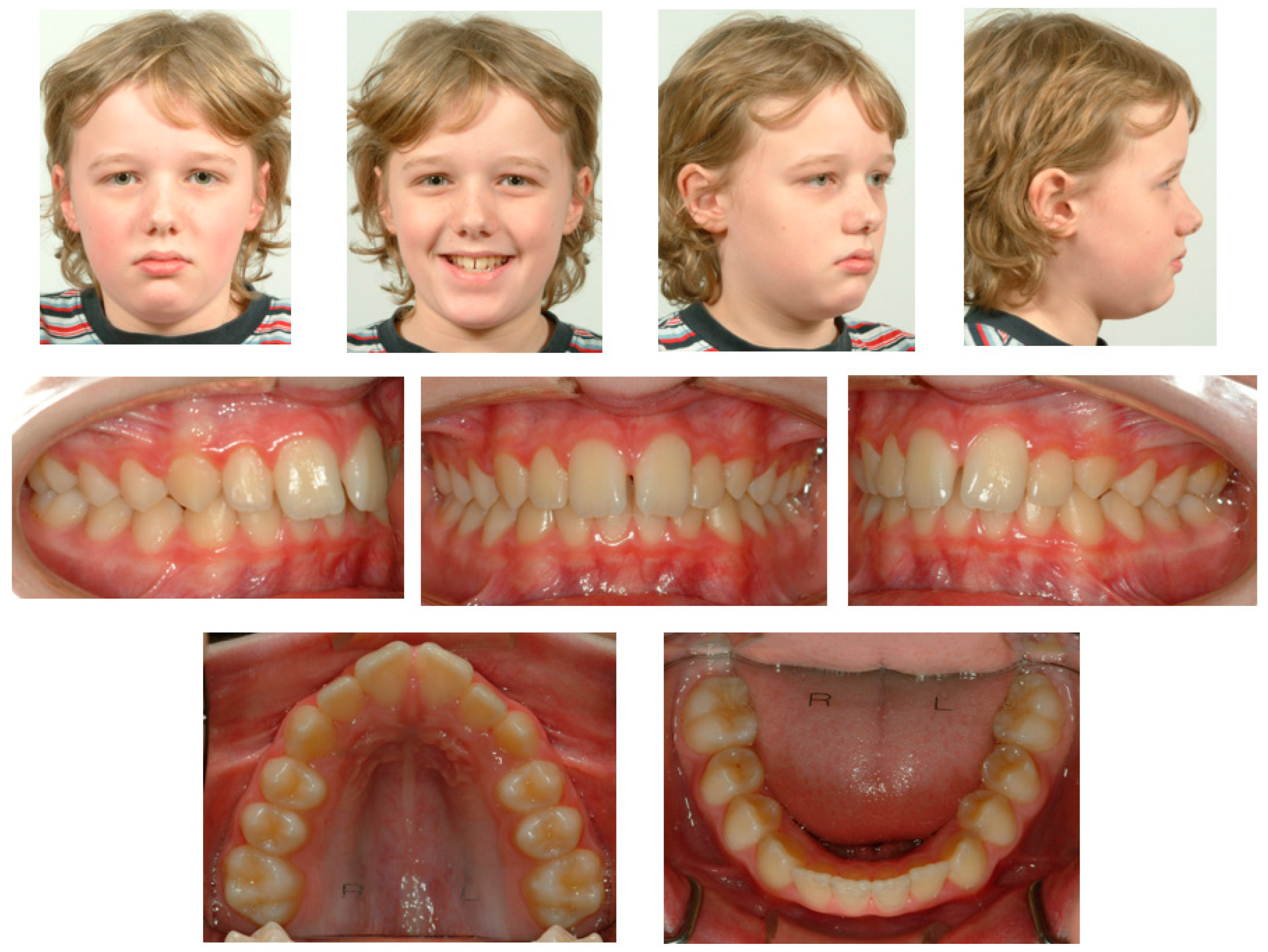
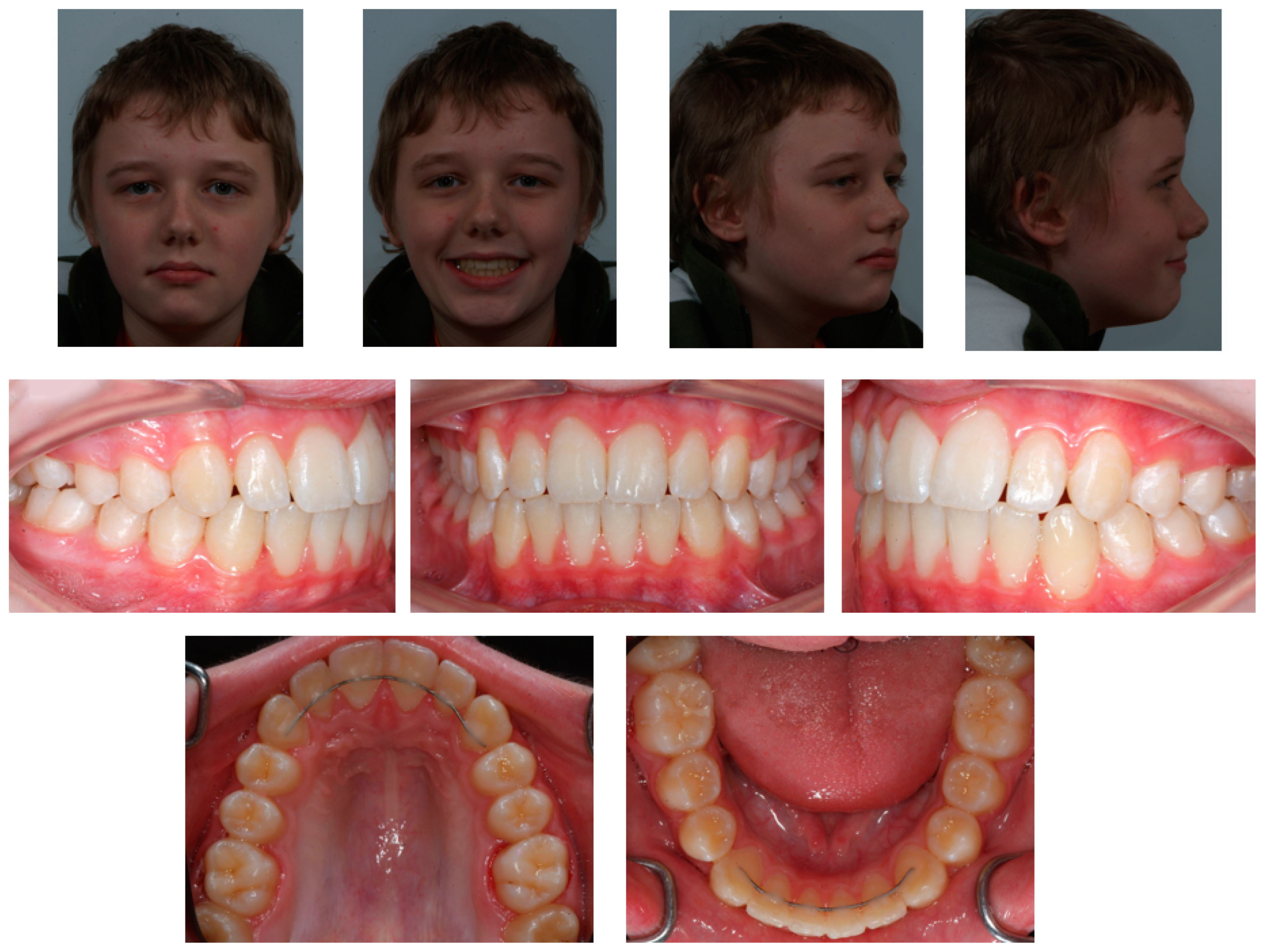

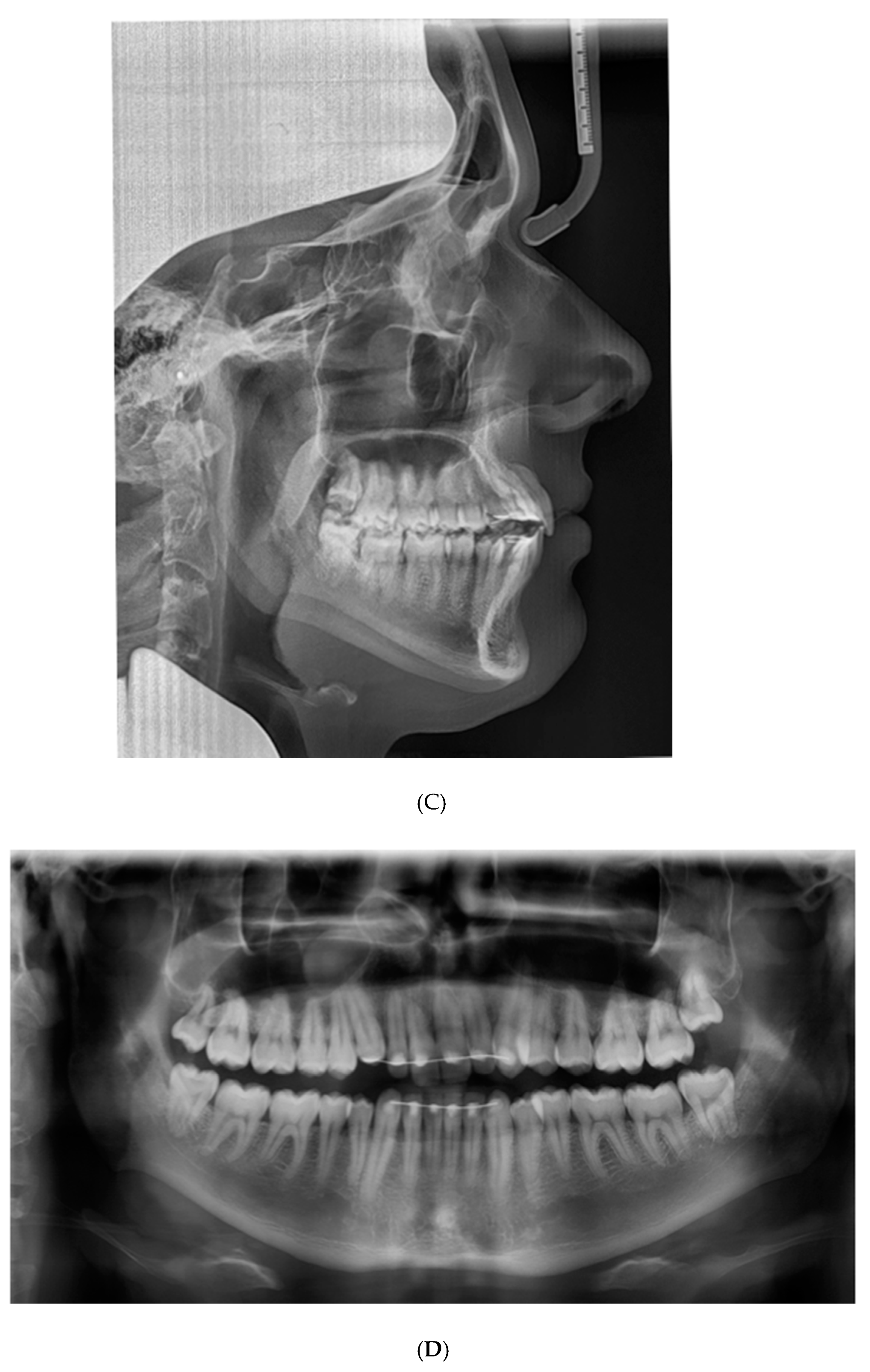
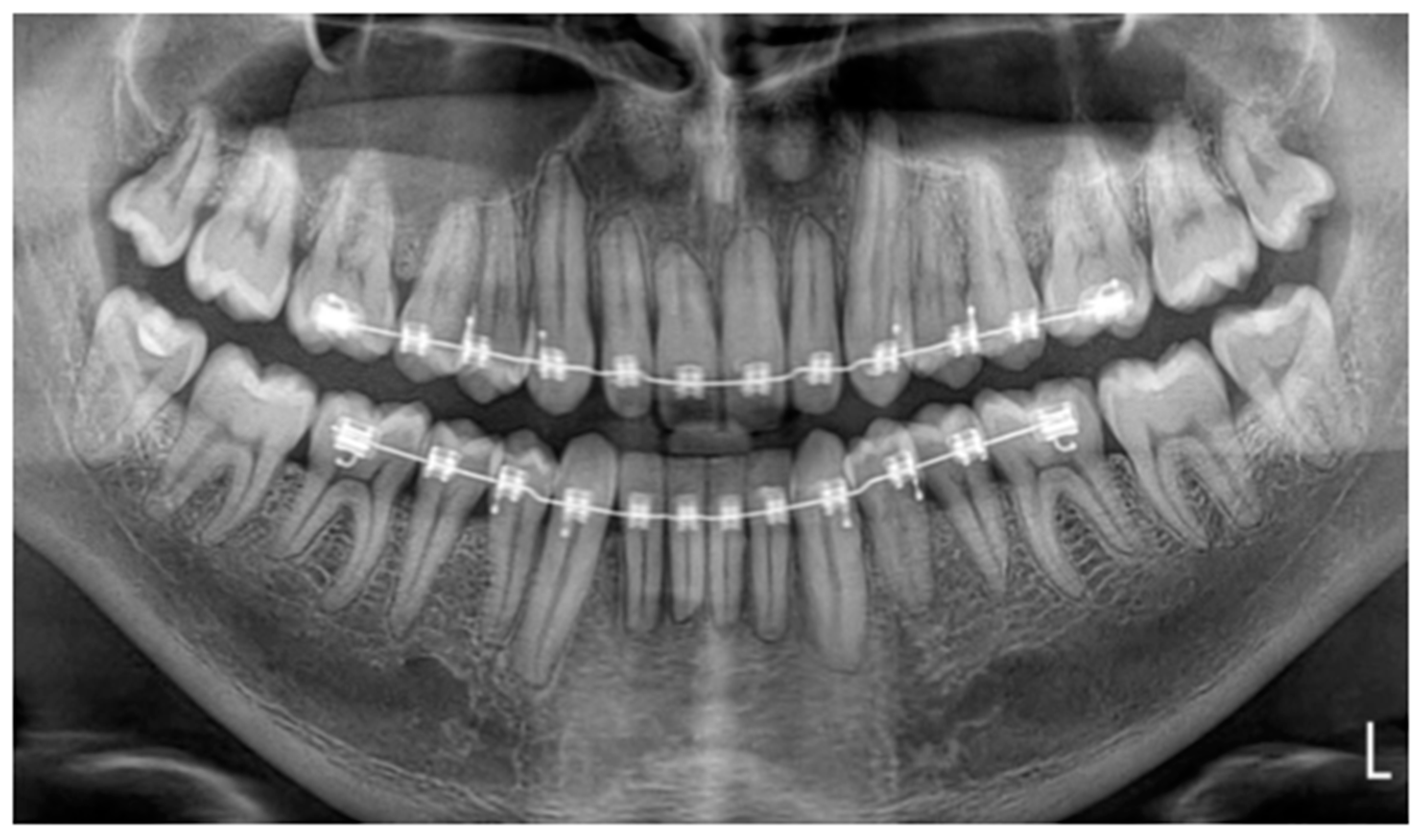

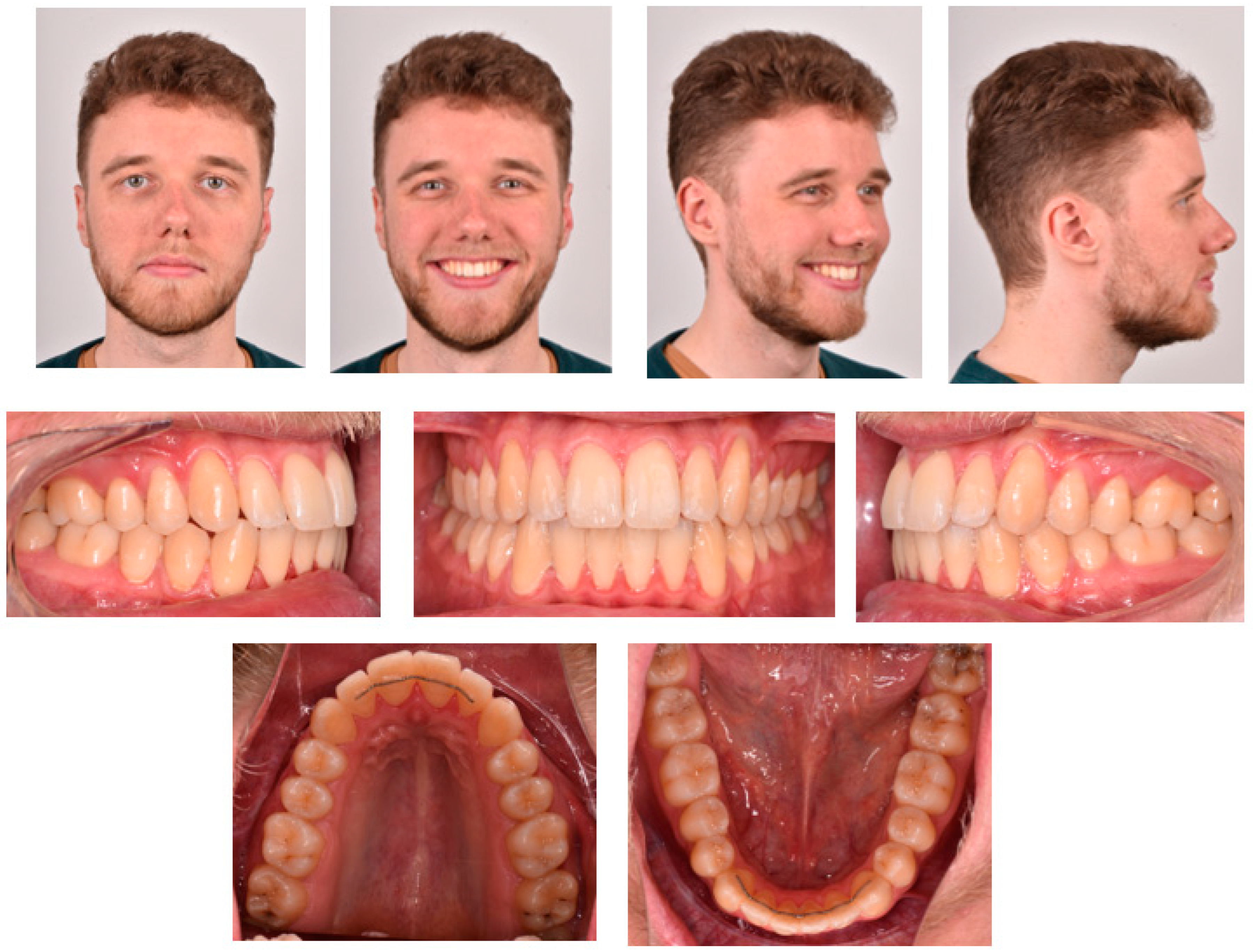
| Intervention | Description |
|---|---|
| Removal of the fixed flexible spiral wires | Maxilla: 0.0195-inch, 3-strand, heat-treated twist wire (Wildcat, GAC International, Bohemia, NY, USA) located on the palatal surface 13-12-11-21-22-23 Mandible: 0.0195-inch, 3-strand, heat-treated twist wire (Wildcat, GAC International, Bohemia, NY, USA) located on the lingual surface 33-32-31-41-42-43 |
| Fixed appliance therapy | Type: 3M Victory Series APC conventional twin brackets (3M Victory Series APC conventional twin brackets, 3M Health Care Division, London, Canada) Prescription: MBT Slot system: 0.022-inch Wires: 0.012-inch NITI *, 0.014-inch NITI*, 0.016-inch NITI *, 0.018-inch NITI*, 0.016 × 0.022-inch NITI *, 0.017 × 0.025-inch NITI *, 0.016 × 0.022-inch SS **, 0.017 × 0.025-inch SS ** Overlay wires: 0.012-inch NITI *, 0.014-inch NITI *, 0.016-inch NITI *, 0.018-inch NITI * |
| Retention therapy | Maxilla: 0.016 X 0.016-inch, 8-stranded, braided rectangular wire (Forestaflex, Forestadent®, Bernhard Förster GmbH, Pforzheim, Germany) located on the palatal surface of 12-11-21-22 in combination with a vacuum-formed retainer Mandible: 0.016 × 0.022-inch, 8-stranded, braided rectangular wire (Forestaflex, Forestadent®, Bernhard Förster GmbH, Pforzheim, Germany) located on the lingual surface of 33-32-31-41-42-43 |
Disclaimer/Publisher’s Note: The statements, opinions and data contained in all publications are solely those of the individual author(s) and contributor(s) and not of MDPI and/or the editor(s). MDPI and/or the editor(s) disclaim responsibility for any injury to people or property resulting from any ideas, methods, instructions or products referred to in the content. |
© 2023 by the authors. Licensee MDPI, Basel, Switzerland. This article is an open access article distributed under the terms and conditions of the Creative Commons Attribution (CC BY) license (https://creativecommons.org/licenses/by/4.0/).
Share and Cite
Steegmans, P.A.J.; Jonkman, R.E.G.; de Lange, J. Fixed Flexible Spiral Wire Retainers and Unwanted Tooth Movements: A Case Report. Appl. Sci. 2023, 13, 922. https://doi.org/10.3390/app13020922
Steegmans PAJ, Jonkman REG, de Lange J. Fixed Flexible Spiral Wire Retainers and Unwanted Tooth Movements: A Case Report. Applied Sciences. 2023; 13(2):922. https://doi.org/10.3390/app13020922
Chicago/Turabian StyleSteegmans, Pauline A. J., Ronald E. G. Jonkman, and Jan de Lange. 2023. "Fixed Flexible Spiral Wire Retainers and Unwanted Tooth Movements: A Case Report" Applied Sciences 13, no. 2: 922. https://doi.org/10.3390/app13020922
APA StyleSteegmans, P. A. J., Jonkman, R. E. G., & de Lange, J. (2023). Fixed Flexible Spiral Wire Retainers and Unwanted Tooth Movements: A Case Report. Applied Sciences, 13(2), 922. https://doi.org/10.3390/app13020922






